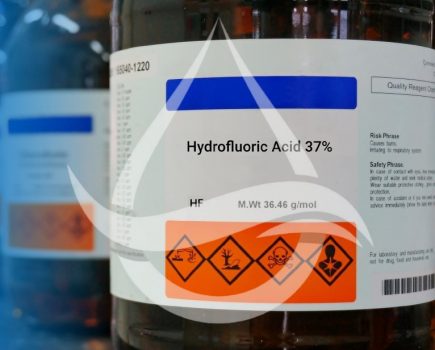Introduction:
Hydrofluoric acid (HF) is a powerful and highly corrosive inorganic acid that finds numerous applications across various industries. This essay endeavors to provide an in-depth review of its versatile applications, highlighting its chemical properties, safety considerations, as well as its impact on the environment and human health.
Hydrofluoric Acid – A Chemical Profile
As I have said, HF acid, with the chemical formula HF, is composed of hydrogen and fluorine atoms. It exhibits unique properties due to its ability to form hydrogen bonds with water molecules, leading to its strong corrosive nature. The weak hydrogen bonds in HF contribute to its reactivity and versatility in different applications.
Industrial Applications of Hydrofluoric Acid
Hydrofluoric acid is widely utilized in the chemical industry as a precursor and catalyst in various reactions. It serves as an essential component in the production of fluorocarbons, which are used as refrigerants and propellants. HF is also employed in the purification of petroleum, as a flux in metalworking operations, and in the production of high-purity silicon for microelectronics.
Pharmaceutical and Analytical Uses
The pharmaceutical industry extensively relies on hydrofluoric acid for synthesizing and modifying certain drug compounds. HF is utilized in the preparation of select antibiotics, anticancer agents, and pharmaceutical intermediates. Additionally, it plays a crucial role in the analysis of silicate minerals and glass surfaces in spectroscopy, aiding in the determination of their chemical composition.
Glass Etching and Glassware Production
Another key point, Hydrofluoric acid is frequently employed in glass etching processes, enabling the creation of intricate designs on glass surfaces. Glassware manufacturers also use it to remove impurities and to ensure smooth and defect-free glass production. By selectively etching glass, HF enables the creation of personalized art, decorative pieces, and intricate patterns on glass surfaces.
Hydrofluoric Acid in Petroleum Refining and Oil Extraction
In the petroleum industry, hydrofluoric acid serves as an essential catalyst for the alkylation of isobutene with olefins, aiding in the production of high-octane gasoline. Its use in the refining process helps enhance fuel quality and performance. Industries utilize HF in acidizing treatments during oil extraction to overcome formation damage and improve the permeability of reservoir rocks.
Electroplating and Metal Cleaning
This acid finds application in electroplating processes, where it aids in the deposition of various metals such as gold, silver, and platinum. Its ability to dissolve metallic oxides makes it an effective agent for cleaning metals and removing oxidation layers from surfaces prior to plating or surface finishing procedures.
Hydrofluoric Acid in Silicon Wafer Fabrication
The semiconductor industry relies heavily on hydrofluoric acid for the production of silicon wafers. Industries use it for etching silicon in desired patterns and removing unwanted silicon oxide layers during the fabrication of integrated circuits, solar cells, and other microelectronic components.
Safety Considerations and Handling Precautions
Due to its highly corrosive and toxic nature, industries must follow proper safety measures when handling HF acid, including wearing safety equipment such as gloves, goggles, and protective clothing. In case of exposure or accidents, immediate medical attention is essential to mitigate potential severe health consequences associated with HF exposure.
Environmental Impact and Waste Management
HF acid can have adverse effects if released into the environment. It is important to handle and dispose of HF waste responsibly, adhering to established regulations. To minimize its environmental impact and prevent water source contamination, industries must implement proper storage, neutralization, and recycling procedures.
Conclusion:
as a result, the applications of HF acid are vast and span across numerous industries including chemical, pharmaceutical, glassware, petroleum refining, and semiconductor manufacturing. Despite its versatility, the handling and usage of hydrofluoric acid require utmost caution and adherence to safety protocols. Increased awareness regarding safety precautions and responsible waste management will contribute to the sustainable utilization of this powerful substance.









